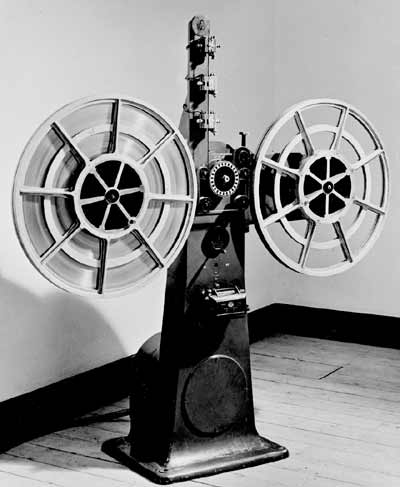
As early as 1900 the Danish engineer Valdemar Poulsen (1869-1942) was demonstrating his Telegraphone at the Paris Universal Exhibition. This machine magnetically recorded telegraphy transmissions on a steel wire. In 1924 Dr. Kurt Stille (1873-1957), a German engineer, developed a practical office dictating machine which was produced by the Vox Gramophone Company. This, too, recorded onto steel wire but the quality fell far short of broadcast standards. The BBC became aware of this machine and closely followed developments in magnetic recording. Its interest increased with the coming of the Empire Service, where the same programme would be repeated several times for different time zones.
Film producer and showman Louis Blattner (1881-1935), a German who lived in England, formed a company to develop and market Stille's inventions. Among the projects that he set his engineers was to produce a machine which he hoped could be used as a source of sound synchronised to film.
In September 1930 a machine was installed for trials at Avenue House, then the home of the BBC's Research Department and the results were deemed good enough for speech, but not for music. The BBC negotiated a five-year rental agreement with the British Blattnerphone Company in January 1931 at £500 for the first year, £1000 per year thereafter, plus £250 for each additional machine.
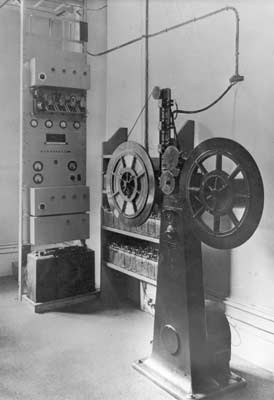
At the end of 1932 a programme called "Pieces of Tape" was produced in the Blattnerphone room, being a compilation of several tapes recorded that year. However, the mechanics of the editing process were too laborious for regular productions using the technique.
The following February a second 3mm machine arrived. Designed (by von Heising of the British Blattnerphone Company) and built in England it was bench mounted and used two A.C. motors, one for the tape drive and the other for the spools. Although it was better engineered and more reliable than the other machines it was mechanically noisy and had worse speed constancy than the original machine.
By now the original 6mm machines were being used only for transferring the recordings they had made to discs. The 3mm machines required considerable maintenance effort to keep them working, and this had an impact on the number of bookings that could be fulfilled. When the Marconi Company bought the Blattnerphone rights in March 1933 they offered to sell the BBC the four rented machines. The Corporation wanted British Blattnerphone to replace all four with a new improved design from Marconi as soon as possible. In the meantime it hired three machines of the von Heising design which were installed by January 1934.
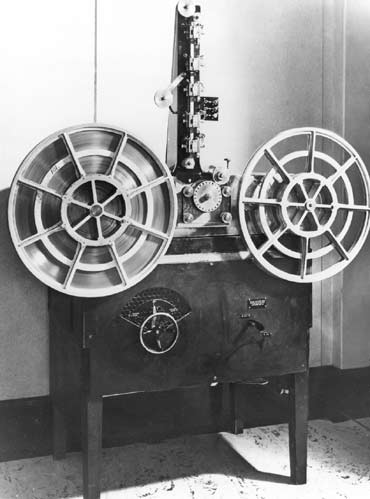
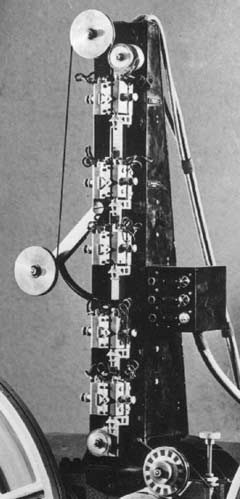
These machines had five heads on the central pillar - spare record and play heads had been added allowing immediate change-over should one of the heads fail. This seems to have been done at the suggestion of BBC engineer R. C. (Reggie) Patrick, then working for Research Department, who was installing the BBC machines. When an edit damaged the pole pieces the other head was brought into contact with the tape and the damaged head's pole pieces were replaced.
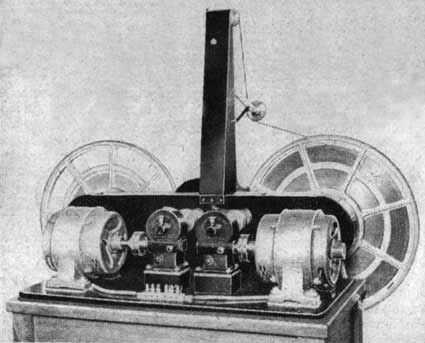
The two motors were of similar type. The left one, via
gearing and a friction clutch, drove the left spool and, via a V-section
belt and similar clutch, the right one too. The clutches were adjusted so
that the tape was just in tension and when the main tape drive was applied
the tape would unwind from one spool and take up on the other.
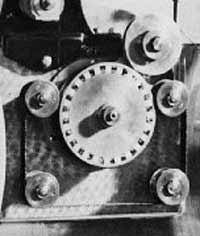
The second motor was connected through a worm gear and flexible coupling to drive a flywheel, which was rigidly coupled to the 'driving wheel', or capstan. The motion of the driving wheel was transmitted to the tape by a moving canvas friction belt which ran round four jockey pulleys (one of which was adjustable) and also passed below the driving wheel.
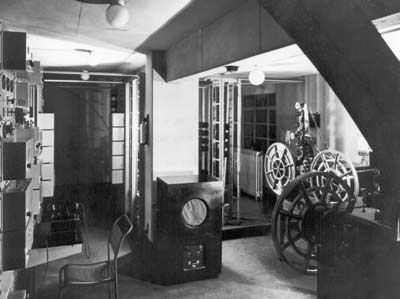
Related page
Footnote by Jim Butterworth
I came across the Blattnerphone when we tried to interest the BBC Governors
in setting up a museum at the Washford transmitting station. Senior management
meetings were held in the early 1980s to discuss the issues. The final answer,
sent to me by the BBC Secretary, was that the BBC is in the broadcasting business
and could not spend money on a museum.The Blattnerphone had been one of several historical BBC items stored unofficially in a number of places and subsequently dispersed so parts became separated. I scoured round for many of the parts, including the head assembly, which had found its way to Start Point – I had to crawl under a large piece of equipment to retrieve it.
The two original machines provided by Louis Blattner used 6mm wide steel tape which weighed about 10kg and used a mile of tape in 20 minutes. The preserved machine is probably the third one to be delivered in 1932, and was the first to use 3mm wide tape.
When I got the machine going, Reg Patrick, the BBC Engineer responsible for installing the Blattnerphones in the 1930s, helped me with advice and a number of the original and specially made pole pieces.
I made up a (valved) amplifier with the right equaliser settings and to provide DC bias. Erase was DC through the erase head. Power came from a substantial induction motor to give fairly constant speed at the capstan, but it was very difficult to set up the clutches to maintain reasonable tension on the tape all the time.
I had to wear thick gloves when working with the machine – on record and replay the reels of steel tape whirled round at quite a speed and during fast rewind it was wise to step right back in case of breakage. Health & Safety wouldn't permit it today! Most of the tapes I found were rusty; however a reasonable one enabled me to record and play sufficiently well to prove that it worked - though way short of broadcast quality. I was able to demonstrate the Blattnerphone working at a BVWS meeting back in the 80s.
At the time, I was a BBC Engineer working at Washford Cross. Edward Pawley and other senior BBC staff had produced a number of books about the technical history of the BBC who were at the forefront of technological advances at the time. I was fortunate to drive around the country (my own time and expense) to see some of the hardware before it was finally dispersed. Much of this could have been saved had the BBC Governors decided otherwise, though I have to agree their decision was correct in the circumstances.
Footnote by Roger Derry
It was in 1987. As Assistant Organiser Production Facilities I occasionally,
with David Stripp from Engineering management, organised internal to the BBC
exhibitions by manufacturers. This one was in studio 8A at the top of Broadcasting
House and was a two day event. The first was a closed day for managers and
senior operational staff. The second was advertised in the BBC Magazine "Ariel" and entirely open to all staff. The manufacturer was the German company Sennheiser and on the first day we heard a presentation by Manfred Hibbing, Sennheiser's designer. The core design innovation was to reduce the noise figures which was done by leaving the mechanical resonances undamped and to equalize them out electrically.
On the second day there was a considerable number of people visiting all of who looked like the "usual suspects". Then about four o'clock a figure who stood out came in. He seemed to be in his 70s and was wearing a black 3-piece suit with a fob watch in his waist coat. Indeed he was in his 70s: "I've come up for the Savoy Hill reunion dinner" he said "so I thought I would come and look at the exhibition".
This was Reggie Patrick, as I discovered when I introduced myself. That was a fairly impressive opening line that was trumped by his next statement. He looked round 8A and said "I accepted this studio when BH was opened". (This is the full engineering test required before the studio could be used). Then that statement was itself trumped as we went on to talk about the purpose of the exhibition - new microphones. He started to talk about spending night shifts testing new microphones; many of them with Alan Blumlein, the legendary pioneer of stereophonic sound and electronic television. Reggie said how one of the best tests was rattling a bunch of keys and hearing how well they reproduced. Coincidentally, a few days earlier, I had been at an Institute of Broadcast Sound meeting where the identical method was being advocated for testing radio microphones and their companding systems.
"The best one", he said, "was Alan Blumlein's - the one with the balsa wood diaphragm". I had read about this microphone and knew that it was highly regarded but I was not prepared for what followed. "He had this idea to reduce the noise level. What he did was to leave in all the resonances and equalise them out electrically" This was the very idea that had been presented as new high tech the previous day. So it was with a big smile on my face that I introduced him to Sennheiser's designer.
Returning to steel tape; one of my studio manager colleagues Rowena Taylor had actually edited Marconi Stille steel tape recordings. This involved using a spot welder. She told me that this resulted in a fade-out/fade-in at the edit. This was caused by the temperature of the tape exceeding its Curie point destroying the magnetism. Rowena had also been responsible for transferring old Philips-Miller film recordings to archive 7.5ips tape in the early fifties.
A Memory by Mike Croll
My first experience of the world of archive recordings was when I was working with Bill Manson in about 1969 and he was asked to replay a dozen reels of old steel tape recordings that had been unearthed. There was a feeling that these were probably 30 years old and could be significant. Arrangements were made to have an old Blattnerphone recorder shipped down from the Science Museum, clean it up and connect it to a suitable amplifier. It turned out that the spools were loaded with short lengths of tape that needed to be welded together and the joints ground down before they could be played. The machine made an awful clattering sound as the joints ran through the replay magnetic pole that was pressed against the recordings by springs. The output from the amplifier was recorded on magnetic tape and contained none of the clatter of the mechanics. Sadly, after all the work it turned out that the tapes only contained offcuts and speech recordings of no significance.

